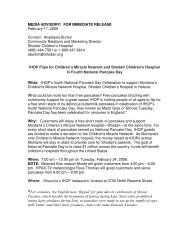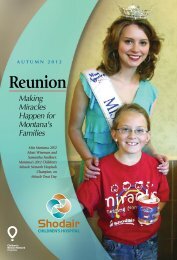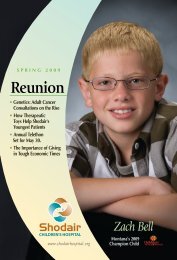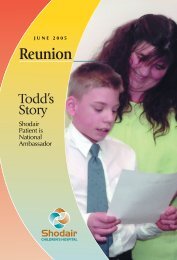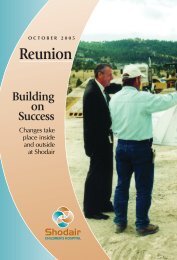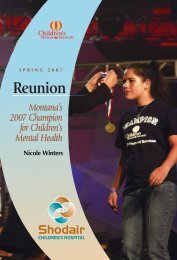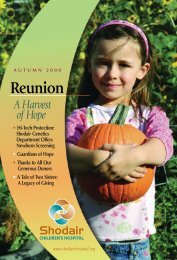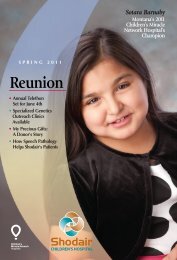SHD Reun 312 - Shodair Children's Hospital
SHD Reun 312 - Shodair Children's Hospital
SHD Reun 312 - Shodair Children's Hospital
- TAGS
- reun
- shodair
- hospital
- shodair.org
Create successful ePaper yourself
Turn your PDF publications into a flip-book with our unique Google optimized e-Paper software.
Tools of the Trade: Happy Children Seriously<br />
Working on Communication Skills<br />
Daylinda Q. Radley, MA, CGC-SLP<br />
Here at <strong>Shodair</strong> <strong>Children's</strong> <strong>Hospital</strong>,<br />
ongoing learning is definitely an important part of my<br />
job to ensure I'm applying techniques that are<br />
effective in helping our patients<br />
make necessary gains. It's<br />
also an excellent way to stay<br />
innovative and current as I<br />
continuously strive to use<br />
tools and technology that are<br />
relevant to today's generation.<br />
Our patients who receive speech<br />
therapy services<br />
have the opportunity to use intervention<br />
tools that target a variety<br />
of needs. For example, the<br />
speech pathologist and teacher<br />
collaborative program on our<br />
High Desert Unit, which is<br />
home to our youngest patients, have now focused on<br />
the introduction of Story Grammar Marker and Braidy:<br />
The Story Braid in the classrooms. These are evidencebased<br />
multi-sensory programs that entail the use of<br />
manipulatives, a puppet, visual icons, and graphic<br />
organizers that support the comprehension of literary<br />
materials, promote oral language development and<br />
enhance writing skills, to name a few of its benefits.<br />
Needless to say, the younger kids have enjoyed the<br />
arrival of Braidy the puppet as they learn about<br />
character's emotions and settings while working on<br />
their ability to recall details and re-tell the stories. The<br />
older ones are noticeably defining characters more<br />
elaborately and are starting to identify the "kick off<br />
events" in each story.<br />
The social stories and Behavior Mapping Strategy are<br />
fast becoming one of the most popular intervention<br />
methods used in the hospital. A few social stories have<br />
now been thoughtfully and individually written for the<br />
younger children and pre-adolescents at <strong>Shodair</strong> to<br />
target specific social skills deficits that cause frequent<br />
conflicts or that prevent them from being successful<br />
in the classroom or community.<br />
For example, “Jaime,” who has been struggling with<br />
transitioning from activity to another, has a social<br />
story entitled "Why I<br />
Need to Follow a<br />
Schedule," along with<br />
use of visual timers and<br />
visual schedules. These<br />
strategies have gradually<br />
helped Jaime follow her<br />
schedule throughout the<br />
day and understand<br />
why it's important to<br />
be on time.<br />
The Behavior Mapping<br />
strategy is frequently<br />
used for older children<br />
also exhibiting social<br />
skills impairment in their small group and individual<br />
therapy sessions. This graphic organizer has allowed<br />
a teenager like “Mike” to understand why saying<br />
verbally inappropriate things to peers can be harmful<br />
not only to his reputation, but also to his relationship<br />
with others. The Behavior Mapping strategy makes<br />
abstract social concepts concrete by allowing kids<br />
to see the direct correlation of their expected or<br />
unexpected behaviors to others and its impact<br />
to themselves.<br />
<strong>Shodair</strong> Speech-Language Pathologist Daylinda Radley<br />
demonstrates how to use Braidy: The Story Braid puppet.<br />
Many of these tools are available at <strong>Shodair</strong> and<br />
are used frequently to promote learning and the<br />
development of skills necessary to be successful in<br />
the real world. These intervention techniques are<br />
definitely not magical in the sense that it makes all<br />
our children's aches and problems disappear. It<br />
does take fidelity of implementation, team effort,<br />
and a lot of patience to reach a point of growth.<br />
Having the adequate resources to continue<br />
supporting the vast communication needs of our<br />
patients makes the work worthwhile. It's also a<br />
great way to make work feel a lot like play!<br />
4 <strong>Reun</strong>ion







